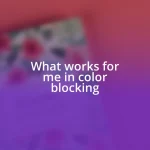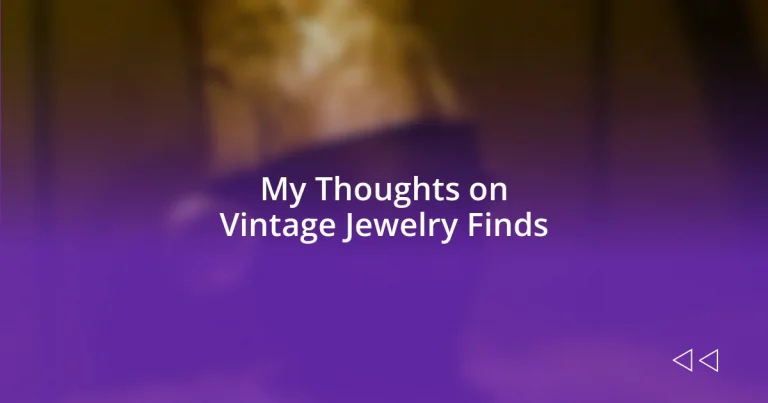Key takeaways:
- Vintage jewelry uniquely combines craftsmanship and history, serving as a personal expression and a connection to the past.
- Identifying authentic vintage pieces involves examining craftsmanship, hallmarks, materials, and construction quality.
- Caring for vintage jewelry requires proper storage, gentle cleaning techniques, and regular maintenance to ensure longevity and preserve their beauty.
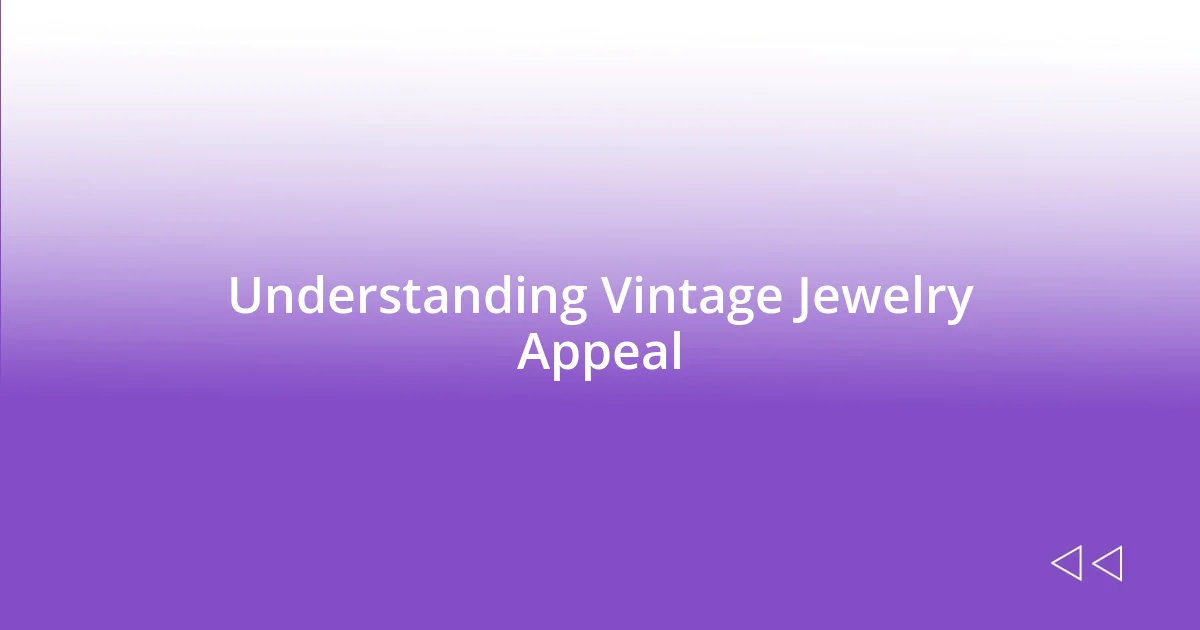
Understanding Vintage Jewelry Appeal
There’s something incredibly captivating about vintage jewelry, isn’t there? Every piece tells a story, evoking a sense of nostalgia that modern items simply can’t replicate. I remember stumbling upon a delicate Art Deco ring at a local flea market, and it felt like I had uncovered a hidden treasure with its intricate design and history whispering through the metal.
The allure often lies in the craftsmanship of these pieces, which reflects a time when artisans poured their heart and soul into every detail. Have you ever noticed how you can feel the difference when you wear something handmade, as opposed to mass-produced? I once wore a vintage brooch to a family gathering, and I instantly felt more connected to my grandmother, who used to wear similar pieces. It was as if the jewelry acted as a bridge, connecting me to her memories and experiences.
Moreover, vintage jewelry has a unique charm that can elevate any outfit, making it a fantastic form of personal expression. When I wear my vintage earrings, I often get compliments and questions about their origin, which opens up wonderful conversations. Isn’t it delightful to think that each piece can not only accessorize but also ignite a dialogue about history and artistry?
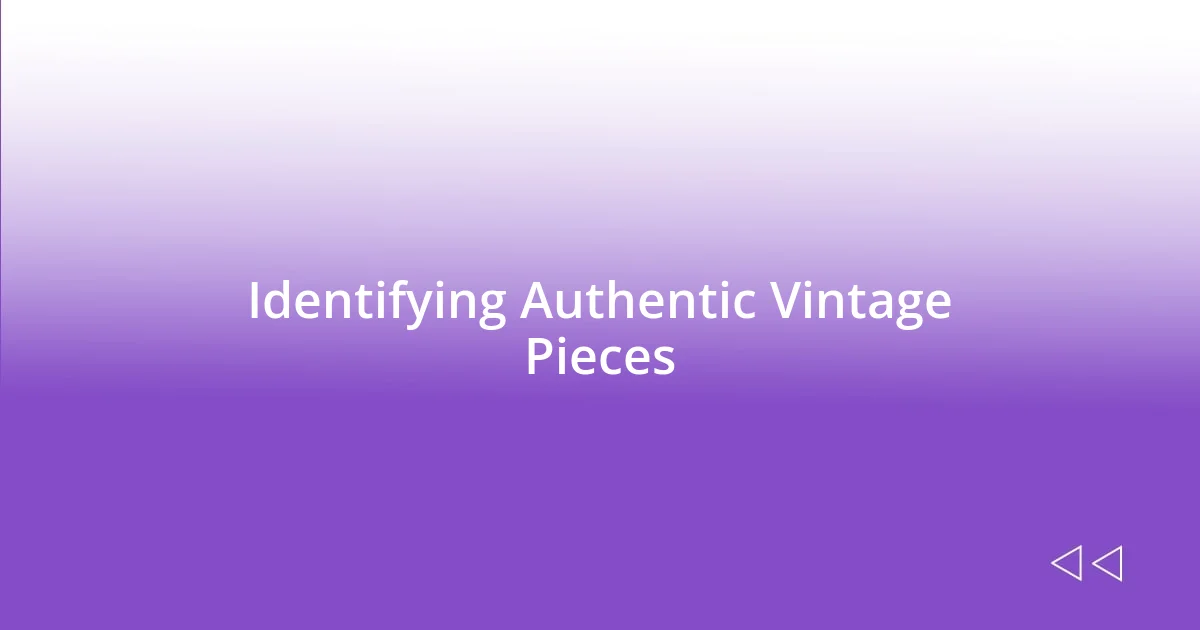
Identifying Authentic Vintage Pieces
When it comes to identifying authentic vintage jewelry, I’ve learned that there are a few key aspects to examine closely. I’ve often found that the craftsmanship is a significant indicator—pieces that are genuinely vintage often showcase intricate detailing, which modern manufacturing processes typically overlook. For instance, during my quest for a vintage Cameo brooch, I marveled at the hand-carved details that exuded an artistry not found in contemporary versions.
Here are some useful tips to help you spot authentic vintage jewelry:
- Hallmarks and Stamps: Look for maker’s marks or stamps on the clasp or back, which can indicate authenticity and age.
- Materials Used: Vintage pieces often feature materials like real gemstones, high-quality metals, and unique enamel work, while modern pieces might lean toward synthetic materials.
- Construction: Pay attention to the construction quality—vintage jewelry tends to be sturdier and heavier than mass-produced counterparts.
- Patina: A natural patina adds character and proves age; polished surfaces might indicate a piece is more recent.
- Style Consistency: Familiarize yourself with vintage design trends from specific decades to spot pieces that fit those patterns.
Each time I dive into the world of vintage jewelry, I feel a rush of excitement at the potential discoveries, knowing that every piece has its own story waiting to be uncovered.
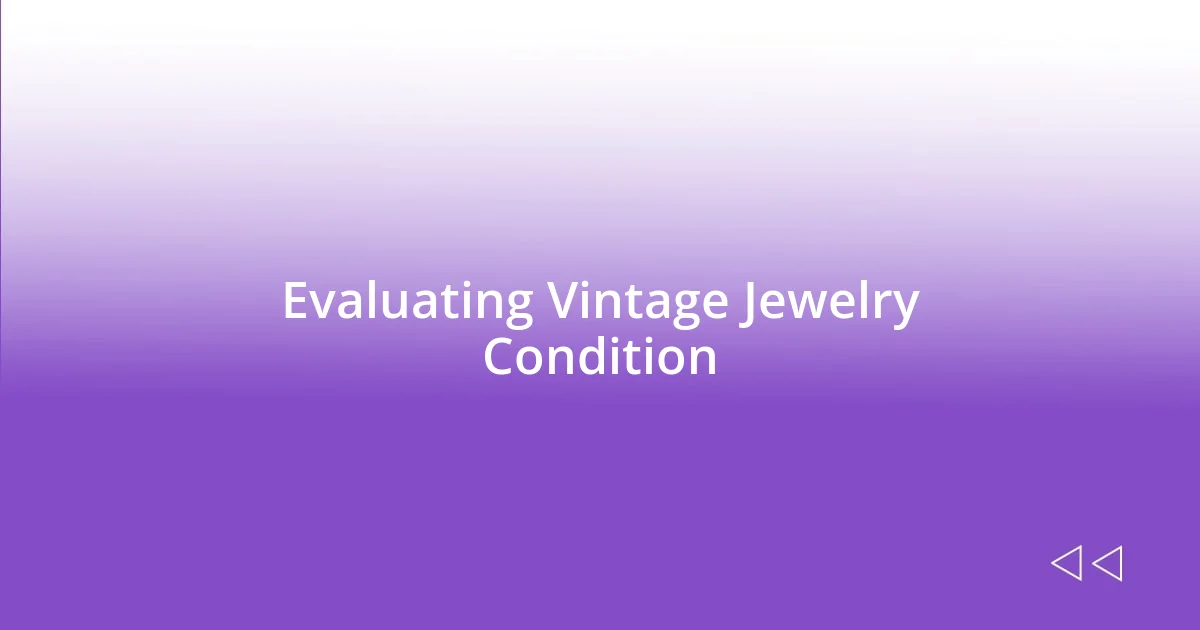
Evaluating Vintage Jewelry Condition
Evaluating the condition of vintage jewelry is essential for any collector or enthusiast. I’ve often found that a thorough inspection can reveal much about a piece’s story and value. For instance, when I first acquired a beautiful Victorian bracelet, I didn’t just admire its aesthetic; I examined the clasp, the stones, and the overall wear. Each tiny scratch and the patina told me how much life it had lived. This is critical because condition heavily influences pricing and desirability in the vintage market.
I like to categorize the condition of vintage items into a few key levels: mint, excellent, good, and fair. Each category reflects how well the piece has been preserved and whether it has undergone any repairs. I remember discovering a pair of vintage earrings that were “good” rather than “mint.” While they weren’t in perfect shape, their charm still captured my heart. They served as a reminder that beauty can exist even in imperfection.
Here’s a quick overview that summarizes what to look for when evaluating vintage jewelry condition:
| Condition Level | Description |
|---|---|
| Mint | Like new with no signs of wear. |
| Excellent | Minor wear, but overall in great shape. |
| Good | Visible signs of wear, may need minor repairs. |
| Fair | Significant wear, major repairs needed. |
Understanding these condition levels can significantly enhance your collecting experience. Have you ever thought about how much a few scratches can tell you about a piece’s journey? It’s like holding onto a tangible piece of history, and for me, that’s what makes vintage jewelry so special.
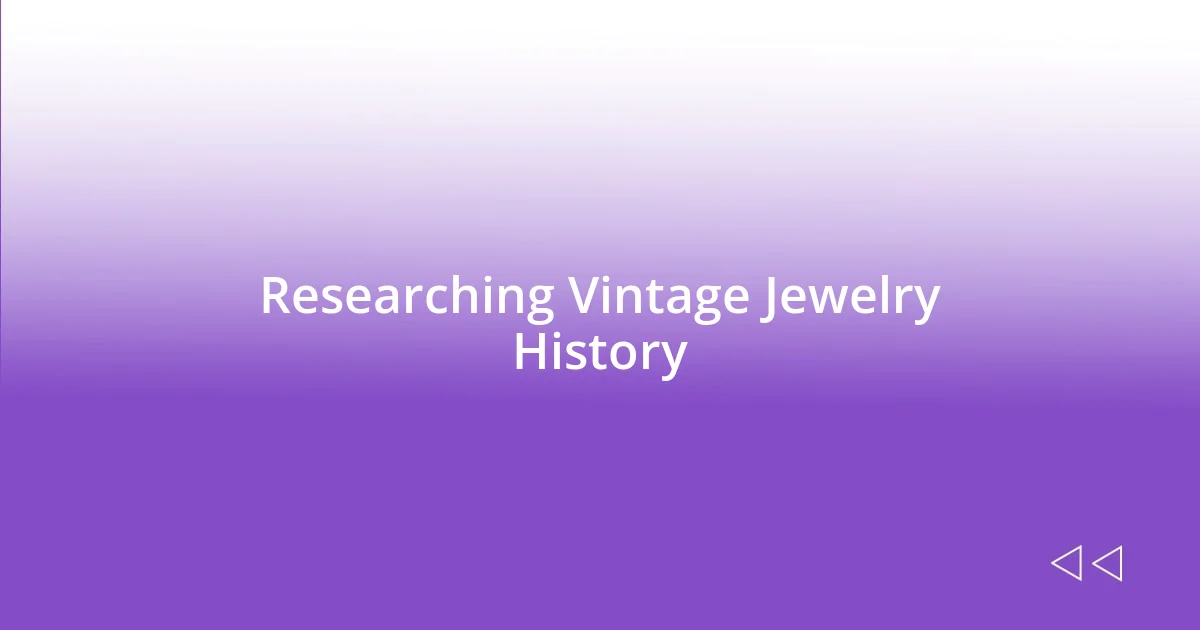
Researching Vintage Jewelry History
Researching the history of vintage jewelry can be a deeply enriching experience. I remember the first time I stumbled upon a beautiful Art Deco ring at a local antique shop. That moment sparked my curiosity about the era it came from, and I found myself diving into the elegant world of the 1920s, learning about its cultural influences and the artisans who created such remarkable pieces. Isn’t it fascinating how a single item can connect us to a specific time and place?
One of the most rewarding aspects of researching vintage jewelry history is discovering the stories behind the styles and materials used. I often explore design manuals or vintage fashion books to understand the context of the pieces I come across. For example, when I came across a stunning piece adorned with marcasite stones, I learned that this trend was popularized in the Edwardian era, becoming a symbol of wealth and class. It adds a layer of appreciation when I wear or showcase such jewelry, knowing the beauty and significance it held in its time.
I encourage you to consider where your favorite pieces fit within their historical timeline. Have you ever wondered what story a vintage locket could tell? By investigating the era and craftsmanship, we unlock narratives that make each piece not just jewelry but a treasured fragment of history.
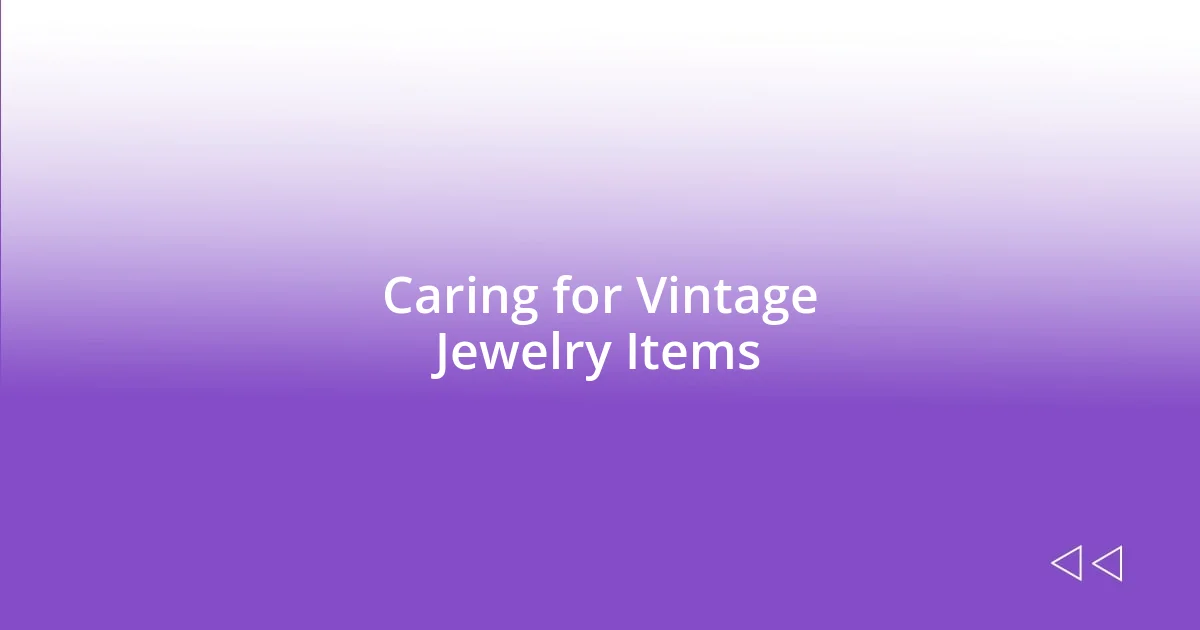
Caring for Vintage Jewelry Items
Caring for vintage jewelry requires a gentle touch and a bit of knowledge. I remember the first time I attempted to clean a delicate brooch; I was so nervous about damaging it that I nearly left it untouched. After researching proper care techniques, I realized that a soft, damp cloth or a specialized jewelry cleaning solution was the safest way to preserve its luster without causing harm. It’s a reminder that patience and the right approach can truly enhance the beauty of these treasures.
Another key aspect of care is storage. I’ve learned the hard way that tossing vintage pieces into a jumbled jewelry box can lead to scratches and tangling. Now, I keep my vintage finds in individual pouches or compartments, protecting each piece while allowing them to breathe. This not only helps maintain their condition but also makes it easier for me to admire them whenever I want. Have you ever thought about how proper storage can prevent potential damage?
Lastly, regular checks on the settings and clasps are essential. On one occasion, I noticed a stone slightly loose in an antique ring after wearing it out; it was a nail-biting moment for me! Fortunately, I was able to take it to a local jeweler for a simple fix before it fell out. This experience taught me that being proactive about maintenance can prolong the life of vintage jewelry and help me enjoy it without worry.
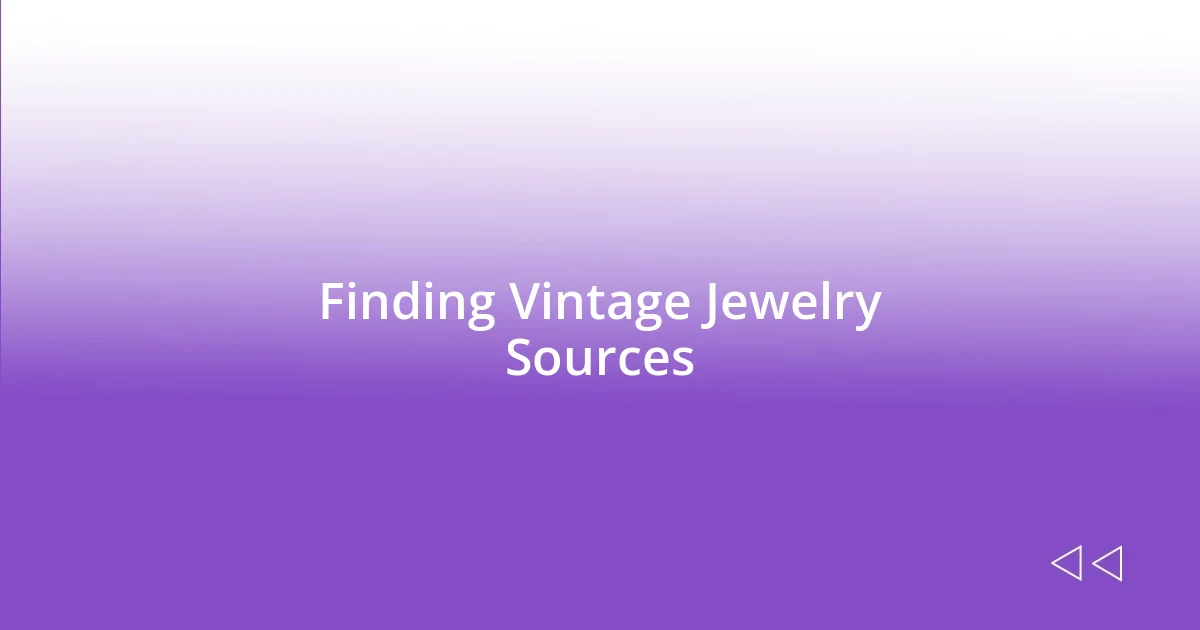
Finding Vintage Jewelry Sources
Finding reliable sources for vintage jewelry is like embarking on a treasure hunt, filled with excitement and the potential for unexpected discoveries. I remember a rainy Saturday morning when I decided to explore a local flea market. As I wandered through the stalls, I stumbled upon an elderly vendor with an array of gorgeous pieces laid out on a table, each seemingly whispering tales from the past. The thrill of finding that unique bracelet amidst the usual items can truly be exhilarating. Have you ever felt that rush of joy when spotting something special?
Beyond flea markets, estate sales can be another goldmine for vintage jewelry finds. I had the pleasure of attending one after seeing an ad online. The moment I stepped inside, I was greeted by a charming collection of jewelry boxes overflowing with gems from decades ago. I discovered a lovely pair of vintage earrings that had belonged to the homeowner’s grandmother. The emotional connection to the artifact, knowing it was once cherished by someone else, makes the experience all the more meaningful. It’s moments like these that remind us that behind each piece is a story waiting to be uncovered.
While online marketplaces offer convenience, nothing beats the feeling of holding a piece in your hand before purchasing. I once decided to try my luck on a website that specializes in vintage jewelry. Although I found plenty of amazing pieces, I hesitated when the photo didn’t quite capture the sparkle I hoped for. This experience reinforced my belief that sourcing vintage jewelry in person often allows for a deeper connection and a more informed choice. Have you had a similar experience of trusting your instincts over pictures?
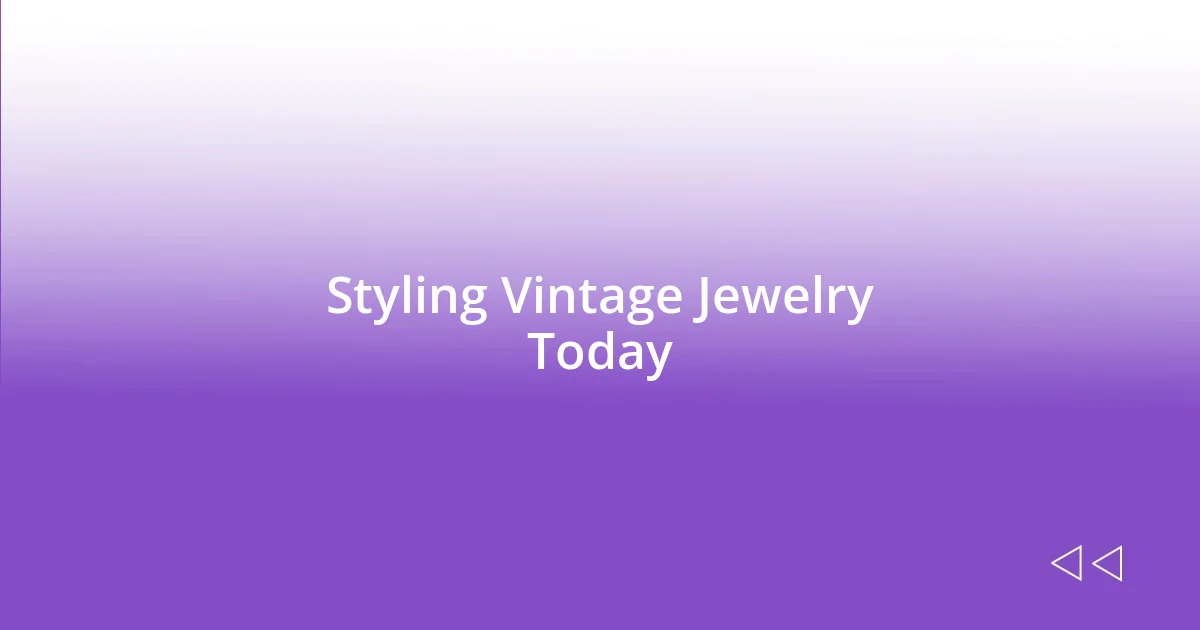
Styling Vintage Jewelry Today
Styling vintage jewelry today is all about mixing the old with the new. I love pairing an intricate vintage necklace with a simple modern dress. It’s fascinating how a single statement piece can transform an outfit, giving it character and a dash of history. Have you ever noticed how vintage jewelry can spark the most delightful conversations?
Layering multiple vintage bracelets has become one of my favorite ways to express individuality. I remember one day, I threw on three different pieces, each from a different decade, and the combination was stunning. It felt like I was narrating a personal story through my accessories, showcasing my unique flair. How do you like to incorporate layers into your everyday style?
Don’t shy away from bold earrings either—they can be a game-changer. I discovered this when attending a friend’s wedding; I wore a pair of vintage Art Deco drop earrings that caught everyone’s eye. Their unique design complemented my outfit beautifully, making me feel both glamorous and one-of-a-kind. Have you found any vintage pieces that have made you feel like the best version of yourself?

